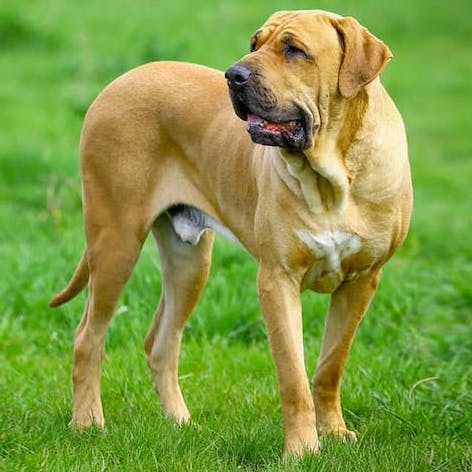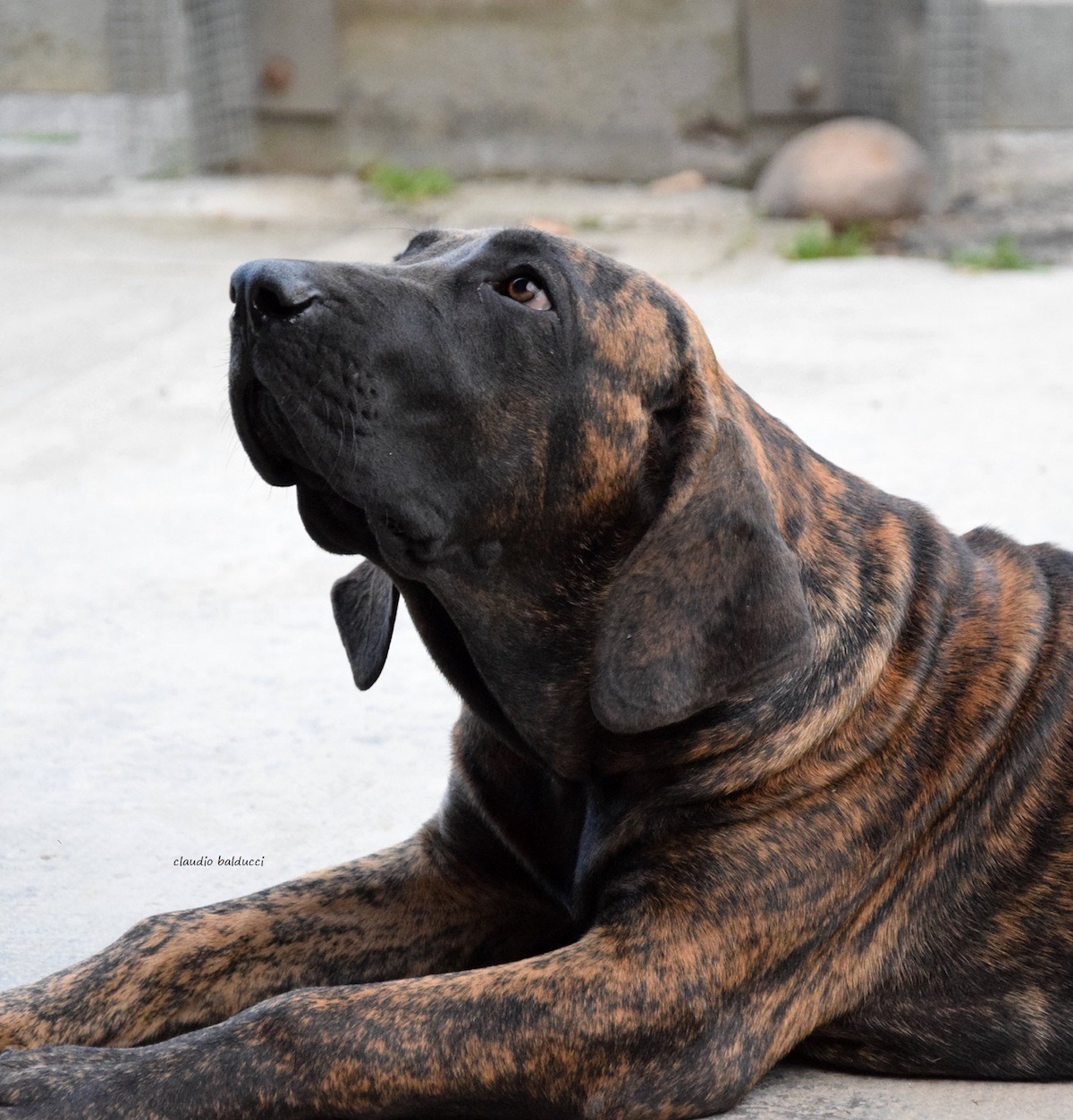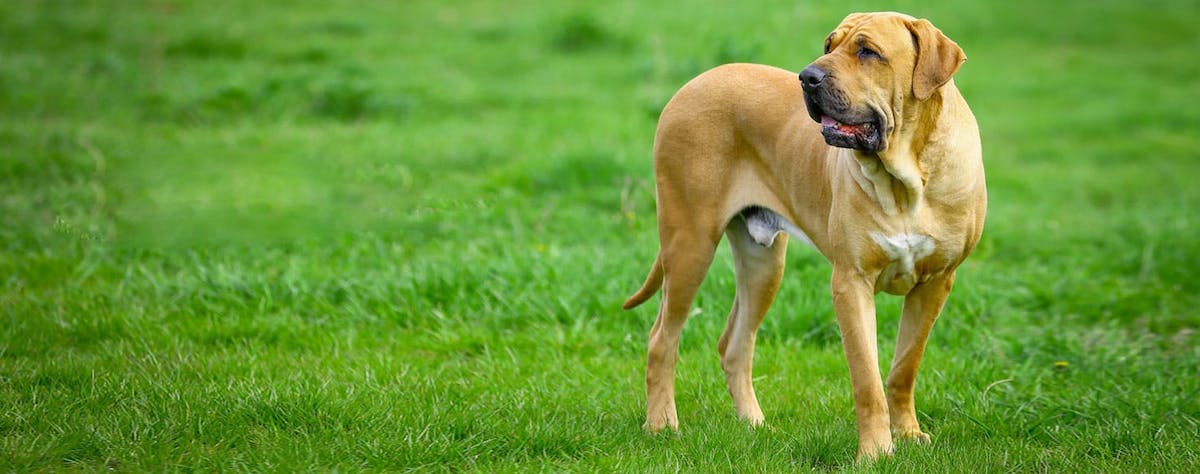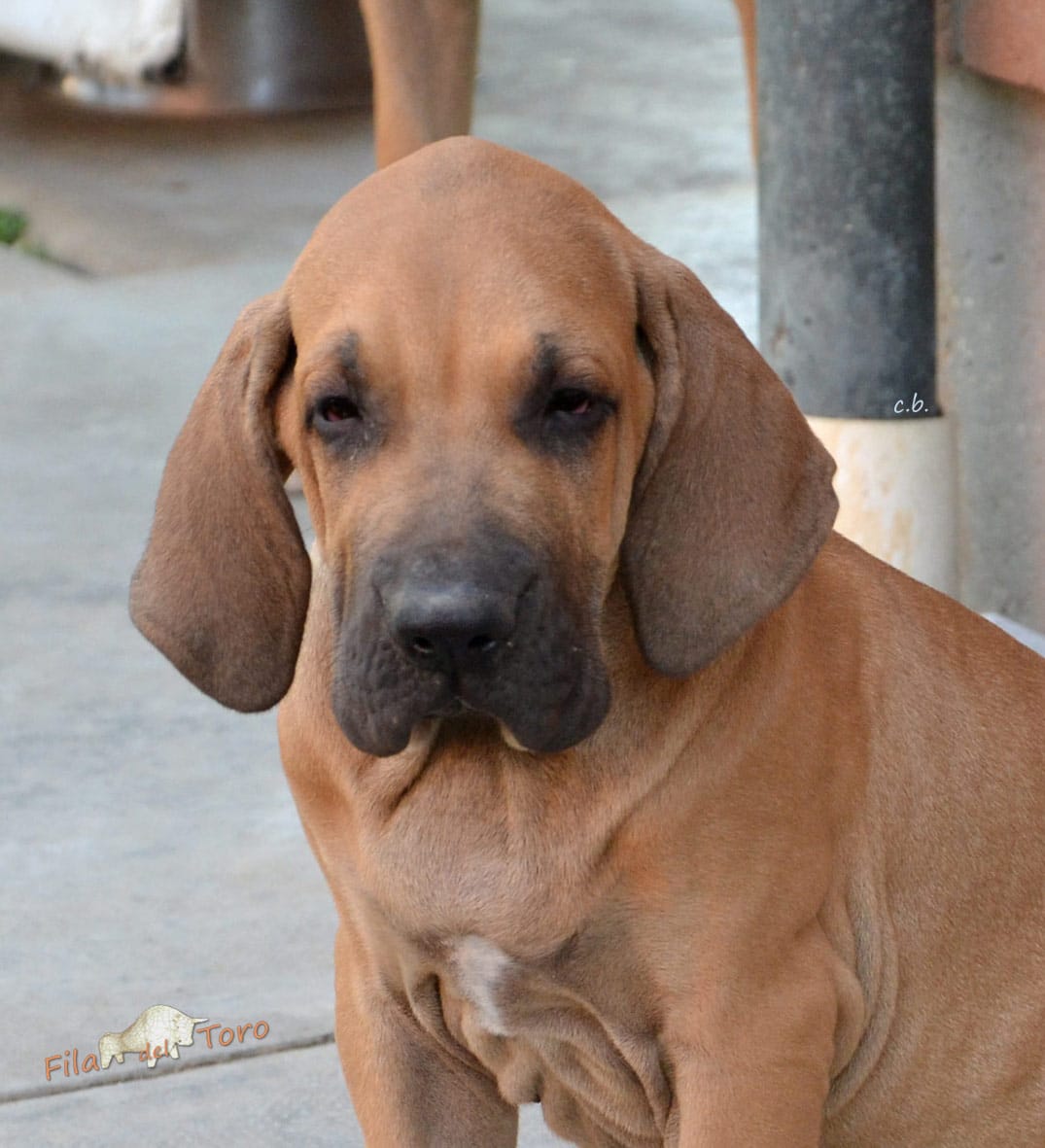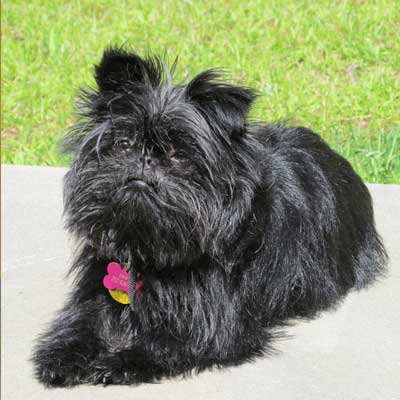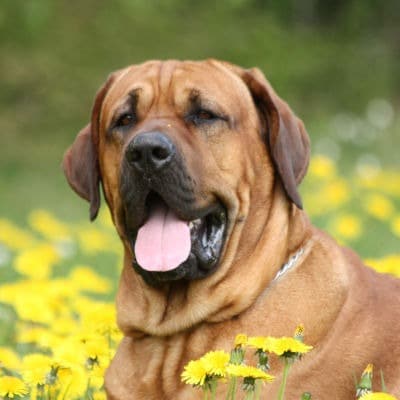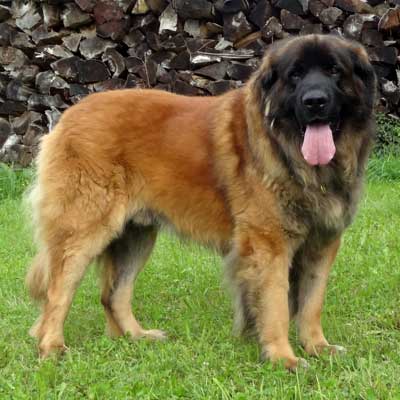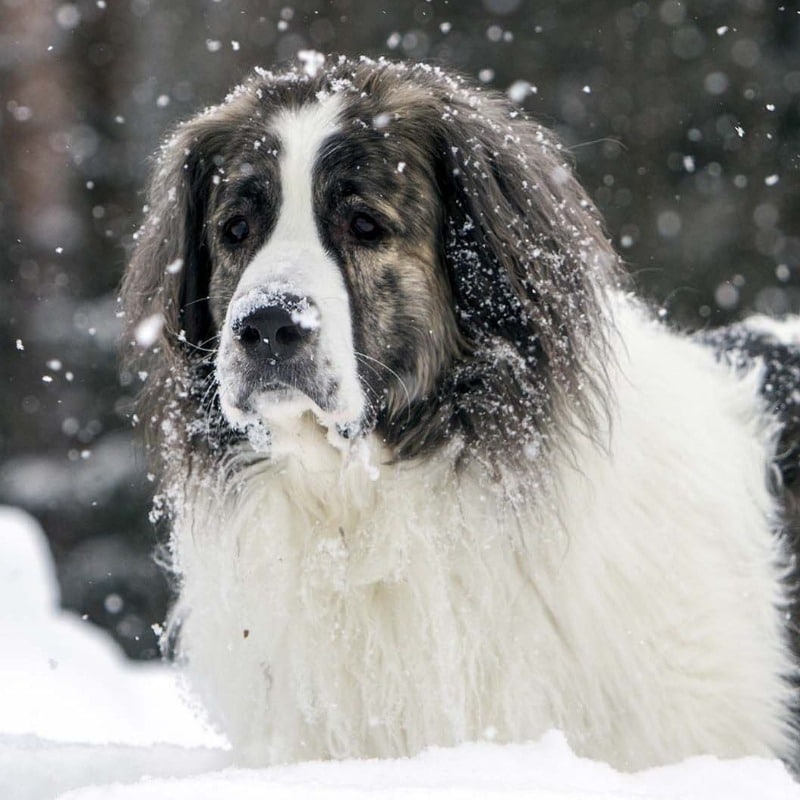Fila Brasileiro
An unsurpassed guardian of properties, it also instinctively indulges in big game hunting and cattle herding
-
Head
The head of the Fila is big, heavy and massive, always proportionate to the whole body. From a top view it resembles a trapezoid figure into which a pear shape is inserted -
Head - cranial region
Skull: The profile of the skull shows a smooth curve from the stop to the occiput, which is well-defined and protuberant especially in puppies. From a front view it is large, broad with the upper line slightly curved. Lateral lines come down almost vertically, in a slight continuous curve narrowing towards the muzzle.
Stop: From a front view it is practically nonexistent. The median groove is slight and runs up smoothly to approximately the centre of the skull. Seen from the side, the stop is only slightly pronounced and virtually only formed by the well-developed eyebrows. -
Head - facial region
Nose: Well-developed, broad nostrils not occupying entirely the width of the upper jaw. Colour: black.
Muzzle: Strong, broad and deep, always in harmony with the skull.
Fairly deep at the root but not deeper than long. Seen from above, it is full under the eyes, slightly narrowing towards the middle of the muzzle and again broadening slightly to the front line.
Seen from the side, the muzzle is straight or has a Roman line, but never turned up. The front line of the muzzle is almost perpendicular to the bridge of the nose with a slight depression right under the nose.
Lips: The upper lip is thick and pendulous and overlaps the lower lip in a perfect curve; thus the lower line of the muzzle is almost parallel to the upper line. The lower lip is tight and firm to the fangs and from there on it is loose with dented borders ending at the corners which are always apparent. The muzzle has a good depth at the root but without surpassing the length. Edges of the lips form a deep inverted “U”.
Teeth/jaws: The teeth are significantly wider than long. Strong and white. Upper incisors are broad at their root and taper to the edge.
Canines are powerful, well set and well apart. The ideal bite is the scissor bite.
Eyes: From medium to large size, almond shaped, spaced well apart, medium to deep set. Permissible colours - from dark brown to yellow, always in accordance to the colour of the coat. However a darker colour is preferred. Due to the loose skin, many individuals present drooping lower eyelids which are not considered a fault as such; a detail accentuates the melancholic expression which is typical of the breed.
Ears: Pendant, large, thick, V-shaped. Broad at the base and tapering to the ends. Rounded tips. Attached at the back of the skull, in line with the eyes when in repose. When roused, the ears are above the original position. The root is oblique, with the front edge higher than the back edge. Falling over the cheeks or folded back showing the inside (rose ear). -
Neck
Extraordinarily strong and muscled giving the impression of a short neck. Slightly curved at the upper side and well detached from the skull. Dewlaps at the throat. -
Body
Strong, broad and deep, covered by thick and loose skin.
The thorax is longer than the abdomen.
Topline: Withers, in sloping line, are set well apart from each other due to the distance between the shoulder blades. Withers are set lower than the croup. After the withers, the upper line changes direction, ascending smoothly to the croup. Back line shows no
tendency to sway or roach back.
Loin/Flanks: Shorter and not so deep as the thorax, showing distinctly the separation of the two component parts.
In females the lower part of the flank is more developed. Seen from above, the loin is narrower than the thorax and croup but should not form a waistline.
Croup: Broad, long, sloping at angle of approximately 30 degrees to the horizontal and ending in a smooth curve. The croup is set a little higher than the withers. From a back view, the croup is ample almost as wide as the chest and can be even broader for females.
Chest: Well-sprung ribs though not interfering with the position of shoulder. Deep and broad chest reaching to the level of the elbows.
Well-pronounced brisket.
Lower line: A long chest and parallel to the ground in all its extension. Slightly tucked up but never whippety. -
Tail
Very wide at the root, medium set, tapering rapidly to reach- the hocks. When the dog is alert, the tail is raised high and the curve at the extremity is more accentuated. Should not be carried curled over the back nor touch it. -
Forequarters
General appearance: The length of the leg, from the ground to the elbow, should be half of the height from the ground to the withers.
Shoulder: The shoulder structure should be composed by two bones of equal length (scapula and humerus); the former at 45 degrees to the horizontal and the latter 90 degrees to the scapula.
The scapula-humeral articulation forms the point of shoulder which is situated at the same level but slightly behind the point of sternum.
In the ideal position, the point of shoulder should be half way from elbow to withers. An imaginary perpendicular line coming down from the withers should cut the elbow and reach the foot.
Forearm: The limbs must be parallel. Strong and straight bones.
Carpal joint (wrist): Strong and apparent.
Metacarpus (pastern): Short, slightly sloping.
Forefeet: Strong and well-arched toes not too close to each other.
The dog stands on thick toes and pads which are long, broad and deep. In the correct position, the feet should point forward. Strong, dark nails; white nails permissible when the corresponding toes are white. -
Hindquarters
General appearance: Less heavy boned than forelegs but never appearing thin compared to the overall build. Hindlegs are parallel.
Upper thigh: Broad with curved outline shaped by strong muscles coming from the ilium and ischium which design the curve of the buttocks and for this reason the ischium must have a good length.
Tarsus (hock): Strong.
Metatarsus (Rear pastern): Slightly sloping, longer than the metacarpus. Moderately angled stifle and hock.
Hind feet: A little more oval than the forefeet but the otherwise identical. Should not present dewclaws. -
Gait / Movement
Long and elastic feline-like strides whose principal characteristic is the pace; a two beat lateral gait in which the legs of each side move back and forth exactly as a pair (“camel’s pace”) causing a rolling or rocking motion of the thorax and hips accentuated by the tail when carried erect. When walking, it carries the head lower than the back line.
The trot is smooth, free and effortless with a long, powerful and reaching stride. The gallop is powerful, attaining unsuspected speed for such a large and heavy dog.
Due to its articulations, typical of molossoids, the movements of the Fila not only give the impression but actually allow him to make sudden and rapid changes of direction. -
Skin
One of the most important breed characteristics is the thick, loose skin over the whole body, chiefly at the neck forming pronounced dewlaps and many times it can extend to the brisket and abdomen. Some individuals present a fold at the sides of the head, also at the withers running down to the shoulders. If the dog is in repose, the head should be free from wrinkles. When alert, the dog raises its ears and the contraction of the skin on the skull forms small
longitudinal wrinkles between the ears. -
Coat - hair
Short, smooth, dense and close to the body. -
Coat - colour
Brindle, fawn and black. A black mask may or not be present. In all permitted colors white marks are allowed on the feet, chest and tip of tail. White markings on other parts of the coat are
considered a fault. -
Size
Height at withers:
Males: from 65 cm to 75 cm at the shoulder. Females: from 60 cm to 70 cm at the shoulder.
Weight:
Males: minimum: 50 kg.
Females: minimum: 40 kg -
Faults
Any departure from the foregoing points should be considered a fault and the seriousness with which the fault should be regarded should be in exact proportion to its degree and its effect upon the health and welfare of the dog.
• Level bite.
• Short muzzle.
• Small ears.
• Highly set ears.
• Excessively light coloured eyes.
• Wrinkles when the dog is in repose.
• Undershot bite.
• Double chin (folds in front of dewlap).
• Sway back.
• Very narrow croup.
• Curled tail carried over the back.
• Chest insufficiently deep.
• Pronounced deviation of pastern or rear pastern.
• Over angulated hindquarters (sickle hocks).
• Short steps (poor reach). -
Serious faults
• Apathy and timidity.
• Square-built.
• Small head.
• Pronounced stop seen from the front.
• Short upper lip.
• Protruding eyes. Round eyes. Lack of pigmentation on eyelids.
• Lack of 2 teeth except PM1 (first premolars).
• Lack of dewlaps.
• Roach back or level back.
• Excessive tuckup.
• Light bones. Lack of substance.
• Cow hocks.
• Lack of angulation at the hindquarters (straight hocks).
• White markings exceeding 1/4th (one fourth) of the body.
• Height exceeding the maximum. -
Diqualifying faults
• Aggressive or overly shy.
• Any dog clearly showing physical or behavioural abnormalities.
• Flesh-coloured nose.
• Overshot bite.
• Undershot bite with teeth visible when the mouth is closed.
• Lack of 1 canine or 1 molar except the 3rd one.
• Wall eyes.
• Cropped ears or docked tail.
• Croup lower than the withers.
• Dog not walking at camel’s pace.
• Skin not loose and supple.
• Dogs which are white, mouse-grey, dappled, black and tan, blue.
• Males under 65 cm and females under 60 cm of height at the shoulder.
• Use of artificial methods to produce certain effects, albinism, lack of type.
N.B.:
• Male animals should have two apparently normal testicles fully descended into the scrotum.
• Only functionally and clinically healthy dogs, with breed typical conformation should be used for breeding.

